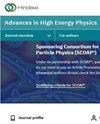Extracting Kinetic Freeze-Out Properties in High-Energy Collisions Using a Multisource Thermal Model
IF 1.1
4区 物理与天体物理
Q3 PHYSICS, PARTICLES & FIELDS
引用次数: 0
Abstract
We study the transverse momentum () spectra of neutral pions and identified charged hadrons produced in proton–proton (pp), deuteron–gold (d–Au), and gold–gold (Au–Au) collisions at the center of mass energy GeV. The study is made in the framework of a multisource thermal model used in the partonic level. It is assumed that the contribution to the -value of any hadron comes from two or three partons with an isotropic distribution of the azimuthal angle. The contribution of each parton to the -value of a given hadron is assumed to obey any one of the standard (Maxwell-Boltzmann, Fermi-Dirac, and Bose-Einstein) distributions with the kinetic freeze-out temperature and average transverse flow velocity. The spectra of the final-state hadrons can be fitted by the superposition of two or three components. The results obtained from our Monte Carlo method are used to fit the experimental results of the PHENIX and STAR Collaborations. The results of the present work serve as a suitable reference baseline for other experiments and simulation studies.利用多源热模型提取高能碰撞中的动力学凝固特性
我们研究了质心能量为 GeV 的质子-质子(pp)、氘核-金(d-Au)和金-金(Au-Au)对撞中产生的中性粒子和已识别带电强子的横动量()谱。研究是在部分子水平使用的多源热模型框架内进行的。假设任何强子的-值都来自方位角各向同性分布的两个或三个粒子。每个粒子对给定强子-值的贡献被假定为服从任何一种标准(麦克斯韦-玻尔兹曼分布、费米-狄拉克分布和玻色-爱因斯坦分布),具有动力学冻结温度和平均横向流动速度。终态强子的光谱可以通过两个或三个分量的叠加来拟合。我们用蒙特卡罗方法得到的结果来拟合 PHENIX 和 STAR 合作组织的实验结果。本工作的结果可作为其他实验和模拟研究的合适参考基线。
本文章由计算机程序翻译,如有差异,请以英文原文为准。
求助全文
约1分钟内获得全文
求助全文
来源期刊

Advances in High Energy Physics
PHYSICS, PARTICLES & FIELDS-
CiteScore
3.40
自引率
5.90%
发文量
55
审稿时长
6-12 weeks
期刊介绍:
Advances in High Energy Physics publishes the results of theoretical and experimental research on the nature of, and interaction between, energy and matter. Considering both original research and focussed review articles, the journal welcomes submissions from small research groups and large consortia alike.
 求助内容:
求助内容: 应助结果提醒方式:
应助结果提醒方式:


